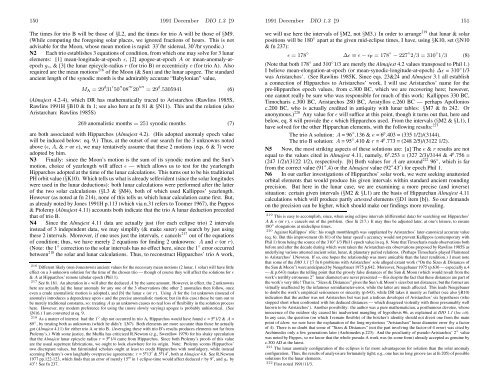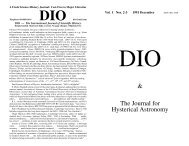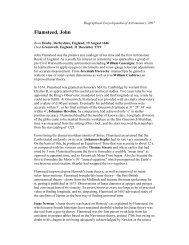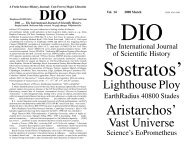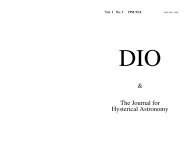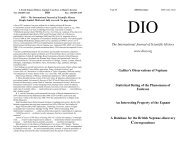DIO 1.2 - DIO, The International Journal of Scientific History
DIO 1.2 - DIO, The International Journal of Scientific History
DIO 1.2 - DIO, The International Journal of Scientific History
You also want an ePaper? Increase the reach of your titles
YUMPU automatically turns print PDFs into web optimized ePapers that Google loves.
150 1991 December <strong>DIO</strong> 1.3 ‡9<br />
<strong>The</strong> times for trio B will be those <strong>of</strong> §L2, and the times for trio A will be those <strong>of</strong> §M9.<br />
(While computing the foregoing solar places, we ignored fractions <strong>of</strong> hours. This is not<br />
advisable for the Moon, whose mean motion is rapid: 33 ′ /hr sidereal, 30 ′ /hr synodic.)<br />
N2 Each trio establishes 3 equations <strong>of</strong> condition, from which one may solve for 3 lunar<br />
elements: [1] mean-longitude-at-epoch ɛ, [2] apogee-at-epoch A or mean-anomaly-atepoch<br />
g ◦, & [3] the lunar epicycle-radius r (for trio B) or eccentricity e (for trio A). Also<br />
required are the mean motions 216 <strong>of</strong> the Moon (& Sun) and the lunar apogee. <strong>The</strong> standard<br />
ancient length <strong>of</strong> the synodic month is the admirably accurate “Babylonian” value,<br />
M A = 29 d 31 ′ 50 ′′ 08 ′′′ 20 ′′′′ = 29 d .5305941 (6)<br />
(Almajest 4.2-4), which DR has mathematically traced to Aristarchos (Rawlins 1985S,<br />
Rawlins 1991H §B10 & fn 1; see also here at fn 81 & §N11). This and the relation (also<br />
Aristarchan: Rawlins 1985S)<br />
269 anomalistic months = 251 synodic months (7)<br />
are both associated with Hipparchos (Almajest 4.2). (His adopted anomaly epoch value<br />
will be induced below: eq. 9.) Thus, at the outset <strong>of</strong> our search for the 3 unknowns noted<br />
above (ɛ, A, & r or e), we may tentatively assume that these 2 motions (eqs. 6 & 7) were<br />
adopted by him.<br />
N3 Finally: since the Moon’s motion is the sum <strong>of</strong> its synodic motion and the Sun’s<br />
motion, choice <strong>of</strong> yearlength will affect ɛ — which allows us to test for the yearlength<br />
Hipparchos adopted at the time <strong>of</strong> the lunar calculations. This turns out to be his traditional<br />
PH orbit value (§K10). Which tells us what is already selfevident (since the solar longitudes<br />
were used in the lunar deductions): both lunar calculations were performed after the latter<br />
<strong>of</strong> the two solar calculations (§L3 & §M4), both <strong>of</strong> which used Kallippos’ yearlength.<br />
However (as noted at fn 214), none <strong>of</strong> this tells us which lunar calculation came first. But,<br />
as already noted by Jones 1991H p.113 (which via n.31 refers to Toomer 1967), the Pappos<br />
& Ptolemy (Almajest 4.11) accounts both indicate that the trio A lunar deduction preceded<br />
that <strong>of</strong> trio B.<br />
N4 Since the Almajest 4.11 data are actually just (for each eclipse trio) 2 intervals<br />
instead <strong>of</strong> 3 independent data, we may simplify (& make surer) our search by just using<br />
these 2 intervals. Moreover, if one uses just the intervals, ɛ cancels 217 out <strong>of</strong> the equations<br />
<strong>of</strong> condition; thus, we have merely 2 equations for finding 2 unknowns: A and e (or r).<br />
(Note: the 1 ◦ correction to the solar intervals has no effect here, since the 1 ◦ error occurred<br />
between 218 the solar and lunar calculations. Thus, to reconstruct Hipparchos’ trio A work,<br />
216 Different likely (non-Jonestown) ancient values for the necessary mean motions (2 lunar, 1 solar) will have little<br />
effect on a 3-unknown solution for the time <strong>of</strong> the chosen trio — though <strong>of</strong> course they will affect the solutions for ɛ<br />
& A at Hipparchos’ remote tabular epoch (Phil 1).<br />
217 See fn 161. An alteration in ɛ will alter the deduced A by the same amount. However, in effect, the 2 unknowns<br />
here are actually [a] the lunar anomaly for any one <strong>of</strong> the 3 observations (the other 2 anomalies then follow, once<br />
even a crude anomalistic motion is adopted), and [b] the lunar e (or r). Using A for the 1st unknown (instead <strong>of</strong><br />
anomaly) introduces a dependence upon ɛ and the precise anomalistic motion; but (in this case) these be turn out to<br />
be merely traditional constants, so: treating A as an unknown causes no real loss <strong>of</strong> flexibility in the solution process<br />
here. However, my modern preference for using the (more slowly varying) apogee is probably unhistorical. (See<br />
§N16.) I am converted at eq. 9.<br />
218 As a matter <strong>of</strong> interest: had the 1 ◦ slip not occurred in trio A, Hipparchos would have found e = 5 p 1/2 & A =<br />
89 ◦ , by treating both as unknowns (which he didn’t: §N7). Both elements are more accurate than those he actually<br />
got (Almajest 4.11) for either trio A or trio B. (Averaging these with trio B’s results produces elements not far from<br />
Ptolemy’s.) With some justice, the Muffia has criticized R.Newton (e.g., Swerdlow 1979) for his shaky speculation<br />
that the Almajest lunar epicycle radius r = 5 p 1/4 came from Hipparchos. Since both Ptolemy’s pro<strong>of</strong>s <strong>of</strong> this value<br />
are the usual superneat fabrications, we ought to look elsewhere for its origin. Note: Ptolemy scorns Hipparchos’<br />
two discrepant values, but fairminded scholars ought at least to credit Hipparchos with nonfudgery, while instead<br />
scorning Ptolemy’s own laughably overprecise agreements: r = 5 p 13 ′ & 5 p 14 ′ , both at Almajest 4.6. See R.Newton<br />
1977 pp.122-123, which finds that an error <strong>of</strong> merely 15 m in 1 eclipse-time would affect deduced r by 9 ′ , and g ◦ by<br />
43 ′ ! See fn 237.<br />
1991 December <strong>DIO</strong> 1.3 ‡9 151<br />
we will use here the intervals <strong>of</strong> §M2, not §M3.) In order to arrange 219 that lunar & solar<br />
positions will be 180 ◦ apart at the given mid-eclipse times, I have, using §K10, set (§N10<br />
& fn 237):<br />
ɛ = 178 ◦ ∆ɛ ≡ ɛ − ɛ P = 178 ◦ − 227 ◦ 2/3 = 310 ◦ 1/3 (8)<br />
(Note that both 178 ◦ and 310 ◦ 1/3 are merely the Almajest 4.2 values transposed to Phil 1.)<br />
I believe mean-elongation-at-epoch (or mean-synodic-longitude-at-epoch) ∆ɛ = 310 ◦ 1/3<br />
was Aristarchos’. (See Rawlins 1985K. Since eqs. 23&24 and Almajest 3.1 all establish<br />
a connection <strong>of</strong> Hipparchos to Aristarchos’ work, I will use Aristarchos’ name for the<br />
pre-Hipparchos epoch values, from c.300 BC, which we are recovering here; however,<br />
one cannot really be sure who was responsible for much <strong>of</strong> this work: Kallippos 330 BC,<br />
Timocharis c.300 BC, Aristarchos 280 BC, Aristyllos c.260 BC — perhaps Apollonios<br />
c.200 BC, who is actually credited in antiquity with lunar tables: §M7 & fn 242. Or<br />
anonymous.) 220 Any value for ɛ will suffice at this point, though it turns out that, here and<br />
below, eq. 8 will provide the ɛ which Hipparchos used. From the intervals (§M2 & §L1), I<br />
have solved for the other Hipparchan elements, with the following results: 221<br />
<strong>The</strong> trio A solution: A = 96 ◦ .136 & e = 6 p .403 = (335 1/2)/(3144).<br />
<strong>The</strong> trio B solution: A = 95 ◦ .410 & r = 4 p .773 = (248 2/5)/(3122 1/2).<br />
N5 Now, the most striking aspects <strong>of</strong> these solutions are: [a] <strong>The</strong> e & r results are not<br />
equal to the values cited in Almajest 4.11, namely, 6 p .253 = (327 2/3)/3144 & 4 p .756 =<br />
(247 1/2)/(3122 1/2), respectively. [b] Both values for A are around 222 96 ◦ , which is far<br />
from the correct value (91 ◦ .4) or the Almajest value (92 ◦ 43 ′ ) for epoch Phil 1.<br />
N6 In our earlier investigations <strong>of</strong> Hipparchos’ solar work, we were seeking unattested<br />
orbital elements that would produce his given intervals within standard ancient rounding<br />
precision. But here in the lunar case, we are examining a more precise (and inverse)<br />
situation: certain given intervals (§M2 & §L1) are the basis <strong>of</strong> Hipparchan Almajest 4.11<br />
calculations which will produce partly attested elements (§D1 item [b]). So our demands<br />
on the precision can be higher, which should make our findings more revealing.<br />
219 This is easy to accomplish, since, when using eclipse intervals (differential data) for searching out Hipparchos’<br />
A & e (or r), ɛ cancels out <strong>of</strong> the problem. (See fn 217.) It may thus be adjusted later, at one’s leisure, to ensure<br />
180 ◦ elongations at mideclipse times.<br />
220 Against Kallippos’ rôle: his rough monthlength was supplanted by Aristarchos’ later-canonical accurate value<br />
(eq. 6). But this improvement (fn 81) <strong>of</strong> the lunar speed’s accuracy would not prevent Kallippos (contemporary with<br />
Phil 1) from being the source <strong>of</strong> the 310 ◦ 1/3 Phil 1 epoch value in eq. 8. Note that Timocharis made observations both<br />
before and after the decade during which were taken the Aristarchan-era observations proposed by Rawlins 1985S as<br />
underlying various attested ancient solar, lunar, & planetary period relations. (Perhaps Timocharis played Flamsteed<br />
to Aristarchos’ I.Newton. If so, one hopes the relationship was more amicable than the later rendition.) I must note<br />
that some <strong>of</strong> the <strong>DIO</strong> 1.1 ‡7 fn 6 problems with Aristarchos’ sole alleged extant work (“On the Sizes & Distances <strong>of</strong><br />
the Sun & Moon”) were anticipated by Neugebauer 1975 p.642. Moreover, Neugebauer 1975 (p.636 — especially n.4<br />
— & p.643) makes the telling point that the grossly false distances <strong>of</strong> the Sun & Moon (which would result from the<br />
work’s terribly erroneous 2 ◦ lunar diameter) are never presented — this despite the fact that these distances are part <strong>of</strong><br />
the work’s very title! That is, “Sizes & Distances” gives the Sun’s & Moon’s sizes but not distances; but the former are<br />
virtually unaffected by the infamous semidiameter-error, while the latter are much affected. This leads Neugebauer<br />
to doubt the work’s empirical seriousness or sincerity (p.643), while DR takes it merely as further (see also §R10)<br />
indication that the author was not Aristarchos but was just a tedious developer <strong>of</strong> Aristarchos’ six hypotheses (who<br />
stopped short when confronted with his deduced distances — which disagreed violently with those presumably well<br />
known to be Aristarchos’). Another possibility: the author was a pure mathematician, a posthumous devotee, whose<br />
innocence <strong>of</strong> the outdoor sky caused his inadvertent mangling <strong>of</strong> hypothesis #6, as explained at <strong>DIO</strong> 1.1 (loc cit).<br />
In any case, the question (on which I remain flexible) <strong>of</strong> the botcher’s identity should not divert one from the main<br />
point <strong>of</strong> idem: we now have the explanation <strong>of</strong> the long-mysterious “Aristarchan” lunar diameter error (by a factor<br />
<strong>of</strong> 4). <strong>The</strong>re is no doubt that some <strong>of</strong> “Sizes & Distances” (not the part involving the factor-<strong>of</strong>-4 error) was cited by<br />
Archimedes only a few generations later (Archimedes p.223). And the peculiarity <strong>of</strong> pseudo-Aristarchos’ 2 ◦ value<br />
was noted by Pappos, so we know that the whole pseudo-A work was (in some form) already accepted as genuine by<br />
c.300 AD at the latest.<br />
221 <strong>The</strong> lunar anomaly configuration <strong>of</strong> the eclipses is far more advantageous for solution than the solar anomaly<br />
configuration. Thus, the results <strong>of</strong> analysis are fortunately tight; e.g., one has no long groove (as at fn 205) <strong>of</strong> possible<br />
solutions for the lunar elements.<br />
222 First noted 1991/11/3.


